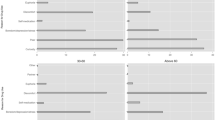Abstract
This study was designed to examine geographic variation in illegal drug purchase opportunity among young people living in the United States; there was a subfocus on age, sex, and urban/rural residence. Data from the 1996–1997 National Household Surveys on Drug Abuse were analyzed; the nationally representative sample of community residents included 21,531 participants aged 12–24 years old. Respondents were asked if someone had approached them to sell them an illegal drug during the past 30 days. To protect responsents’ confidentiality, there is no fine-grained geographical coding of data in the National Household Surveys on Drug Abuse public use data files, but mine geographical divisional indicators are provided (i.e., West Norht Central, New England, etc.). Results indicated males were an estimated 1.8 times more likely than females to have had a recent illicit drug purchase opportunity, and urban residents were 1.5 times more likely than rural residents to have had a recent drug purchase opportunity. As for geographic divisions, the Pacific division surpassed all other divisions: Its residents were 1.5 times more likely to have recent drug purchase opportunities tha the West North Central division (used bere as a reference category). After controlling statistically for age, sex, and urban/rural residence, fresidence in four divisions was foun to be associated with greater likelihood of an illicit drug purchase opportunity. The observed patterns of drug purchase opportunity add new features to our understanding of illicit drug involvement across the United States.
Similar content being viewed by others

References
Van Etten ML, Anthony JC. Comparative epidemiology of initial drug opportunities and transitions to first use; marijuana, cocaine, hallucinogens and heroin. Drug Alcohol Depend. 1999;54(2):117–125.
Rosenberg MF, Anthony JC. Aggressive behavior and opportunities to purchase drugs. Drug Alcohol Depend. 2001;63(3):245–252.
Greene MH, Kozel NJ, Hunt LG, Appletree RL. An Assessment of Diffusion of Heroin Abuse to Medium-Sized Cities. Washingon, DC: Special Action Office for Drug Abuse Prevention; 1974. Special Action Office Monograph, Series A, Number 5.
Van Etten ML, Neumark YD, Anthony JC. Male-female differences in the earliest stages of drug involvement. Addiction. 1999;94(9):1413–1419.
US Department of Health and Human Services. Substance Abuse and Mental Health Services Administration (SAMHSA): National Household Survey on drug Abuse, Main Findings: 1996. Rockville, MD: Substance Abuse and Mental Health Services Administration; 1998; DDHS publication 98-3200.
US Department of Healtg and Human Services. Substance Abuse and mental Health Services Administration (SAMHSA): National Household Survey on Drug Abuse, Main Findings: 1997. Rockville, MD: Substance Abuse and Mental Health Services Administration; 1999. DDHS publication 99-3295.
Anthony JC, Warner AL, Kessler RC. Comparative epidemiology of dependence on tobacco, alcohol, controlled substances, and inhalants: basic findings from the National Comorbidity Survey. Exp Clin Psychopharmacol. 1994;2(3):244–268.
US Census Bureau. 1990 US Census Data: Population and Housing Unit Counts, CPH-2-1.
StataCorp. 1999 Stata Statistical Software, Release 6.0 College Station, TX: Stata Corporation.
Hosmer DW, Lemeshow S. Applied Logistic Regression. New York: Wiley-Interscience; 1989.
Anthony JC, Neumark YD, Van Etten ML. Do I Do what I say? A perspective on self-report methods in drug dependence epidemiology. Stone AA, Turkkan JS, Bachrach CA, Jobe JB, Kurtzmann HS, Cain VS eds. The Science of Self-Report. Mahwah, NJ: Lawrence Erlbaum Associates, Inc.; 2000:175–198.
Van Etten ML, Neumark YD, Anthony JC. Initial opportunity to use marijuana and the transition to first use: United States, 1979–1994. Drug Alcohol Depend. 1997;49(1):1–7.
Robertson EB, Sloboda Z, Boyd GM, Beatty L, Kozel NJ. Rural Substance Abuse: State of Knowledge and Issues Rockville, MD: US Dept of Health and Human Services; 1997. National Institute on Drug Abuse Research Monograph Series.
Gauvin DV, Sannerud CA, Snyder DA, Sapienza FL. Current observations of methamphetamine supply trends in the United States. Paper presented at: June 2000 Annual Scientific Meeting of the College on problems of Drug Dependence; June 17–June 22, 2000; San Juan, Puerto Rico.
Author information
Authors and Affiliations
Corresponding author
Rights and permissions
About this article
Cite this article
James, K.E., Wagner, F.A. & Anthony, J.C. Regional varation in drug purchase opportunity among youths in the United States, 1996–1997. J Urban Health 79, 104–112 (2002). https://doi.org/10.1093/jurban/79.1.104
Published:
Issue Date:
DOI: https://doi.org/10.1093/jurban/79.1.104



